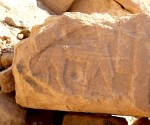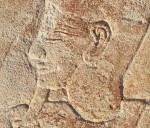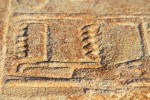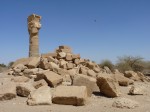 A carving of the god Amun that was defaced by order of Akhenaten has been discovered in a tomb in the necropolis of Sedeinga, Sudan. The slab of Nubian sandstone was 5.8 feet high and 1.3 feet wide and was found in two pieces, broken across the width just above the god’s elbow. The carving was used as a bench for the coffin to rest on in the tomb, but that wasn’t its original intent or location. It was recycled as a mortuary platform several hundred years after it was created in the mid-1300s B.C.
A carving of the god Amun that was defaced by order of Akhenaten has been discovered in a tomb in the necropolis of Sedeinga, Sudan. The slab of Nubian sandstone was 5.8 feet high and 1.3 feet wide and was found in two pieces, broken across the width just above the god’s elbow. The carving was used as a bench for the coffin to rest on in the tomb, but that wasn’t its original intent or location. It was recycled as a mortuary platform several hundred years after it was created in the mid-1300s B.C.
 It was first made to adorn the temple of Queen Tiye, wife of Amenhotep III and mother of Akhenaten. A tribute to the high esteem her husband held her in, the temple presented Tiye as the incarnation of the goddess Hathor and was a companion to a temple to Amenhotep a few miles to the south in Soleb. Tiye’s deification in her lifetime was one of several firsts for a queen of Egypt. She was depicted as a female sphinx, an honor previously reserved for the pharaoh, and attributes of Hathor — the horns and sun disk — were added to headdress is other images. An inscription in the Sedeinga temple calls her “great of fear, mistress of all the lands,” meaning her greatness dominated the women of foreign lands (Sedeinga was part of the Egyptian colony of Nubia during the reign of Amenhotep) just as her husband’s greatness conquered the men.
It was first made to adorn the temple of Queen Tiye, wife of Amenhotep III and mother of Akhenaten. A tribute to the high esteem her husband held her in, the temple presented Tiye as the incarnation of the goddess Hathor and was a companion to a temple to Amenhotep a few miles to the south in Soleb. Tiye’s deification in her lifetime was one of several firsts for a queen of Egypt. She was depicted as a female sphinx, an honor previously reserved for the pharaoh, and attributes of Hathor — the horns and sun disk — were added to headdress is other images. An inscription in the Sedeinga temple calls her “great of fear, mistress of all the lands,” meaning her greatness dominated the women of foreign lands (Sedeinga was part of the Egyptian colony of Nubia during the reign of Amenhotep) just as her husband’s greatness conquered the men.
 Tiye outlived her husband by many years — inscriptions indicate she was living in the 12th year of Akhenaten’s reign — so she may even have been witness to her son’s defacement of her own temple. Akhenaten changed his name from Amenhotep and founded a new religion worshiping the sun disc Aten in the fifth year of his reign. That same year construction began on his new capital Amarna where inscriptions continued to call Tiye queen and beloved of the pharaoh.
Tiye outlived her husband by many years — inscriptions indicate she was living in the 12th year of Akhenaten’s reign — so she may even have been witness to her son’s defacement of her own temple. Akhenaten changed his name from Amenhotep and founded a new religion worshiping the sun disc Aten in the fifth year of his reign. That same year construction began on his new capital Amarna where inscriptions continued to call Tiye queen and beloved of the pharaoh.
 It wasn’t a falling out, therefore, that spurred Akhenaten’s defacement of her temple in Sedeinga. It wasn’t personal; just religious business, part of his policy of chipping away the face and name of Amun in all the major sites, including his mom’s temple in Nubia.
It wasn’t a falling out, therefore, that spurred Akhenaten’s defacement of her temple in Sedeinga. It wasn’t personal; just religious business, part of his policy of chipping away the face and name of Amun in all the major sites, including his mom’s temple in Nubia.
 The new religion could not long outlast its founder, however, and the newly discovered carving attests to the reinstatement of the worship of Amun as well.
The new religion could not long outlast its founder, however, and the newly discovered carving attests to the reinstatement of the worship of Amun as well.
The archaeologists also found that, after Akhenaten’s death, the god’s face and hieroglyphs on this carving were restored. This restoration may have been done during the reign of the boy king Tutankhamun (reign 1336-1327 B.C.), who is famous for his rich tomb.
“The name of Amun as well as his face were first hammered out and later carved anew, proving that the persecution of this god extended to this remote province during the reign of Akhenaton and that his images were restored during the following reigns,” Francigny and Claude Rilly, director of the French archaeological mission in Sedeinga, wrote in the most recent edition of the journal Sudan and Nubia.
 Over time, Tiye’s temple decayed into ruin and people helped themselves to pieces of it. The carving of Amun with its historically significant restored damage was thus preserved in a new location. Today the temple is almost completely gone. All that remains is a single wonky column standing forlornly in a pile of rocks.
Over time, Tiye’s temple decayed into ruin and people helped themselves to pieces of it. The carving of Amun with its historically significant restored damage was thus preserved in a new location. Today the temple is almost completely gone. All that remains is a single wonky column standing forlornly in a pile of rocks.